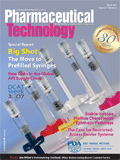March 2007
The proposed rule would impose new record-keeping requirements on some 1200 manufacturing establishments.
REGULATIONS/BIOLOGICS
FDA Proposes Additional Information to Current Biologics Reporting Form
Rockville, MD (Jan. 30)—The US Food and Drug Administration's (www.fda. gov) Center for Biologics Evaluation and Research (CBER) is proposing an addendum to its current biologics reporting form to better classify potential recalls.

FDA must submit such a request to the Office of Management and Budget (Washington, DC, www.whitehouse.gov/omb) for approval but first open the request for a 30-day public-comment period. Notice of the request was published in the Jan. 30, 2007 issue of the Federal Register (1).
Specifically, CBER is developing an addendum to Form FDA 3486, the form now used to report biological product deviations (BPDs). The Web-based addendum (Form FDA 3486A) would request additional information when a BPD report has been reviewed by FDA and evaluated as a possible recall. The additional information would include information not contained in Form 3486 such as distribution pattern, method of consignee notification, consignee(s) of products for further manufacture, additional product information, and updated product disposition.
This information would be requested by CBER via e-mail to the submitter of the BPD report and would be used by CBER for recall classification.
The new form, Form FDA 3486A, would be used only for biological products regulated by CBER and not biological products regulated by the Center for Drug Evaluation and Research.
CBER estimates that 5% of the total BPD reports submitted to CBER would need additional information submitted in the addendum. It estimates that it would take between 15 and 45 minutes to complete the addendum. Activities such as investigating, changing standard operating procedures or processes, and follow-up are not included in the calculation of time for the report.
Reference
1. US Food and Drug Administration, "Agency Information Collection Activities; Submission for Office of Management and Budget Review; Comment Request; Biological Products; Reporting of Biological Product Deviations in Manufacturing; Forms FDA 3486 and 3486A," Federal Register 72 (19), 4267–4269 (Jan. 30, 2007, Docket No. 2006N-0421), http://frwebgate1.access.gpo.gov/cgi-bin/waisgate.cgi?WAISdocID=279262421529+0+0+0&WAISaction=retrieve, accessed Jan. 31, 2007.
-Patricia Van Arnum
MANUFACTURING
Pfizer Wins Court Battle Over Manufacturing Process for Norvasc
New York, NY (Jan. 31)—Pfizer, Inc. (www.pfizer.com) scored a victory over Synthon IP (Gainesville, VA, www.synthonip.com) in a patent infringement lawsuit over the manufacturing process for "Norvasc" (amlodipine). Norvasc is one of Pfizer's top-selling drugs with 2006 sales of $1.3 billion.
According to Pfizer, the federal district court in the Eastern District of Virginia (Alexandria) ruled that Synthon obtained, by inequitable conduct, two US patents that covered a process and an intermediate compound used to make the active ingredient in Pfizer's Norvasc.
Pfizer said the court found that Synthon had knowingly failed to disclose to the US Patent and Trademark Office (Washington, DC, www.uspto.gov) Pfizer publications and other information it had in its possession that described the process Synthon sought to patent.
"It's very difficult to meet the standards for establishing inequitable conduct," said Allen Waxman, Pfizer's general counsel, in a company statement. "But in this case it is clear that Synthon improperly used Pfizer's own published material to obtain a patent that it then tried to enforce against us."
Pfizer said it intends to seek attorneys' fees from Synthon. The case may be appealed.
In its statement, Pfizer explained that Synthon had asserted that Pfizer's process for manufacturing Norvasc infringed Synthon patents issued in 2003 and 2005. In August 2006, a federal court ruled that one of those patents was not infringed by Pfizer and was invalid on multiple grounds, principally because it was based on Pfizer's prior published work. Synthon had dropped its claim of infringement on the second patent prior to trial.
-Patricia Van Arnum
ECONOMICS
User Fees Bolster $2B FDA Budget
Washington, DC (Feb. 1)—The Bush administration's spending plan for 2008 treats the Food and Drug Administration fairly well, considering the cuts directed at Medicare, Medicaid, and children's health programs and flat funding for the National Institutes of Health (NIH). The White House proposes a record $2-billion budget for FDA for the year that starts Sept. 30, 2007. That amount consists of $1.6 billion in appropriated funds, plus some $450 million user fees for drugs, biologics, medical devices, and other products. Even though it's unclear just where the money would come from and just how big the increase really is, the $2-billion total sets a marker for Congress to achieve through some combination of government funding and industry payments.
One problem is that about $45 million in proposed user fees have never been approved by Congress, and may not be this year. The administration wants generic drug makers to pay $16 million in fees to speed up approvals, but industry quickly nixed the idea. They want any fee deal to link to policies halting obstructionist tactics by brands, such as authorized generics.
At the same time, pharmaceutical companies are likely to pay much more than the $340 million user fees in the budget plan for next year. Under the recent proposal for reauthorizing the Prescription Drug User Fee Act (PDUFA), FDA and industry propose to boost fees for drugs and biologics to $400 million per year to support increased oversight of drug safety issues. Congressional leaders plan to address the proposal by summer.
An unusual complication in budget analysis this year is that Congress failed to approve most 2007 spending bills before it adjourned last year, forcing most federal agencies to continue operating at 2006 funding levels. The legislators were still negotiating revised 2007 budget numbers when Bush unveiled the 2008 spending plan, making it difficult to calculate year-to-year increases. Under a Continuing Resolution approved by Congress last month, FDA and NIH were big winners. NIH gained a $600-million budget increase, while FDA was provided $90 million over 2006, for a $1.95 billion total budget for this year. The increase was critical for the agency to continue collecting and increasing user fees and to avoid layoffs of some 650 staffers.
Of almost $50 million in added funds for the Center for Drug Evaluation and Research under the Continuing Resolution for 2007, $35 million goes to the Office of Generic Drugs (OGD) to support faster application approvals. The Bush administration proposes to provide another $5 million next year for OGD, plus the added user fees.
Bigger cuts
Despite its growth, the FDA budget is barely a blip in the administration's $2.9-trillion federal spending plan, or in the $700-billion budget for the US Department of Health and Human Services (most of which is mandated spending for Medicare and Medicaid). Thus, to curb the "unsustainable growth of federal entitlement programs," the Bush administration seeks more than $100 billion in Medicare savings over five years, largely by freezing payments to hospitals, nursing homes, and physicians.
Healthcare providers immediately set in motion plans to kill the fee cuts, while Congressional Democrats fumed that the budget was dead on arrival. Administration supporters described the administration's proposal as the "opening bid" in the battle to reduce the budget deficit, a task made more difficult by huge increases in spending for the war in Iraq.
A controversial proposal is to have wealthier seniors pay higher premiums for Medicare benefits, including premiums for Medicare prescription drug plans. Additional cuts would hit Medicaid and the Children's Health Insurance Program (CHIP), which has to be reauthorized by Congress this year. With pressure high on the legislators to find more money for Medicare, CHIP, and other health programs, added funding for FDA is far from a done deal.
-Jill Wechsler
VACCINES
HHS Offers Liability Protections for Flu Vaccine Manufacturers
Washington, DC (Jan. 26)—The US Department of Health and Human Services (HHS, www.hhs.gov) has granted targeted liability protections for manufacturers of a vaccine to prevent a pandemic of influenza A (H5N1).

The new declaration states that manufacturers of vaccines used to prevent potential avian pandemics will receive immunity from product liability claims. According to the Federal Register notice, it is "intended to alleviate certain liability concerns associated with pandemic countermeasures, and, therefore, ensure that the countermeasures are available and can be administered in the event an avian influenza virus spreads and evolves into a strain capable of causing a pandemic."
With this measure, HHS hopes to encourage the development, clinical testing, manufacture, and distribution of an influenza A vaccine. The declaration went into effect Dec. 1, 2006 and continues through Feb. 28, 2010.
–Brianne Harrison
PROCESSING INGREDIENTS
FDA Proposes Ban on Cattle Tissue in Drugs
Rockville, MD (Jan. 12)—To prevent the spread of bovine spongiform encephalopathy (BSE) and related diseases, the US Food and Drug Administration (www.fda.gov) has proposed banning certain cattle tissues and tissue products from the manufacture of drugs for human and ruminant use.

The proposal, "Use of Materials Derived from Cattle in Medical Products Intended for Use in Humans and Drugs Intended for Use in Ruminants; Proposed Rule" (published in the Jan.12 Federal Register, pp. 1581–1619), estimates that cattle products of some kind are used in 75% of pharmaceutical manufacturing—and 90% of biotechnology processes. The proposal notes, however, that the agency has reviewed 10 years of data on cattle products used in drug-manufacturing and "we are aware of no approved drugs and no investigational drugs that are manufactured with cattle material that would be prohibited under this proposed rule ...."
The rule will, however, impose new record-keeping requirements on some 1200 manufacturing establishments (including an estimated 674 pharma plants and 253 biotech facilities), which must show that their processes do not use the proscribed "Specified Risk Materials." These SRMs are defined as the brain, skull, eyes, trigeminal ganglia, spinal cord, most of the vertebral column, and dorsal root ganglia of cattle 30 months and older, and the tonsils and distal ileum of the small intestine of all cattle.
Manufacturers would be required under 21 CFR Sections 300.200(c)(1), 500.200(c)(1), 600.16(c)(1), 895.102 (c)(1), and 1271.470(c)(1) to maintain records that demonstrate that all cattle-derived materials conform to the prohibition. These could include signed and dated affirmations from slaughterhouses or renderers. The agency estimates the cost of compliance will be small, about $45 to $90 per year, depending on the size of the establishment.
The rule notes that cattle products may be used in manufacturing gelatin, heparin, surfactants, hormones, enzymes, glycosphingolipids, amino acids, glycerol, detergents, blood, collagen, fetal calf serum, bovine meat, and tallow and tallow derivatives.
BSE is a transmissible spongiform encephalopathy (TSE) thought to be caused by prions, for which no screening tests now exist. Human TSEs include Creutzfeld-Jakob Disease (CJD), variant Creutzfeld-Jakob Disease, Gerstmann-Straussler-Scheinker syndrome, kuru, fatal familial insomnia, and sporadic fatal insomnia. Nonhuman TSEs include, in addition to BSE in cattle, scrapie in sheep and goats, transmissible mink encephalopathy, feline spongiform encephalopathy, and chronic wasting disease (CWD) in deer and elk.
-Douglas McCormick
RESTRUCTURING
AstraZeneca Plans Production Rationalization and Job Cuts
London (Feb. 1)—AstraZeneca PLC (www.astrazeneca.com) unveiled a plan to improve asset utilization within its global supply chain that involves rationalizing production assets and cutting staff. The company made the announcement as part of its fourth-quarter and full-year 2006 financial results.

Over the next three years, AstraZeneca plans to rationalize production assets, anticipating accounting charges of roughly $500 million, and reduce its workforce by 3000, subject to consultations with work councils, trade unions, and other employee representatives and in accordance with local labor laws. The company did not disclose which particular facilities would be affected.
"Going forward, management remains committed to maintaining a competitive financial performance during a period when the company, as well as the industry, faces the challenges imposed by patent expirations and pricing pressures from the government and private-sector players," said the company in a prepared statement to explain the rationale for the cost reductions.
For 2006, AstraZeneca reported an 11% sales gain to $26.5 billion and a 28% gain in profit to $6.04 billion.
AstraZeneca acquires biotech company
In another move, AstraZeneca agreed to acquire Arrow Therapeutics Ltd. (London, www.arrowt.co.uk), a privately held biotechnology company, for $150 million. Arrow Therapeutics is focused on the discovery and development of antiviral therapies. It has 57 employees at its facilities in London.
-Patricia Van Arnum
REGULATIONS/SAFETY
FDA Report Details Steps to Improve Safety Programs
Rockville, MD (Jan. 30)—In response to a set of recommendations from the Institute of Medicine (IOM, Washington, DC, www.iom.edu), the US Food and Drug Administration (www.fda. gov) has issued a report detailing a series of initial steps to improve its safety programs.
FDA asked IOM to assess the US drug-safety system in 2005, and IOM released its report, The Future of Drug Safety: Promoting and Protecting the Health of the Public, in Sept. 2006. The report included recommendations about how FDA could improve its drug-safety efforts.
The recommendations FDA intends to act on include: improving communication and information flow among all stakeholders, strengthening the science that supports FDA's medical-product safety system, and improving operations and management to ensure implementation of the review, analysis, consultation, and communication processes needed to strengthen the US drug-safety system.
FDA also signed a memorandum of understanding with the US Department of Veterans Affairs (VA, www.va.gov) to share information related to the review and use of FDA-regulated drugs, biologics, and medical devices. FDA and VA intend to explore ways to enhance risk communication and the collection of postmarket medical-product safety data and promote the efficient use of tools and expertise for medical-product risk identification.
FDA plans to develop scientific approaches to detect, understand, predict, and prevent adverse events. It hopes to develop and incorporate quantitative tools to assess benefit and risk, and it plans to conduct a pilot program to review the safety profiles of certain newly approved drugs on a regularly scheduled basis. FDA also plans to engage external management consultants to help the Center for Drug Evaluation and Research (CDER, www.fda.gov/cder) develop a comprehensive strategy for improving CDER's organizational culture.
If adopted by Congress, many of the recently proposed recommendations for the reauthorization of the Prescription Drug User Fee Act will respond to some of the IOM recommendations, thus providing increased resources for drug safety and added flexibility to FDA in the use of fee funding to address the entire drug life cycle.
-Brianne Harrison
STANDARDS
EPCglobal Ratifies New Electronic Pedigree Standard
Brussels, Belgium (Jan. 11)—EPCglobal (www.epcglobalinc.org), the not-for-profit organization dedicated to driving global adoption of the Electronic Product Code (EPC), has ratified the electronic pedigree document specification.
The new electronic pedigree standard is designed to help companies that are serializing products using EPC technology to comply with pedigree regulations. Its initial focus was the Florida Drug Pedigree Act, but it can be used as a platform to support a wide variety of pedigree process applications.

According to EPCglobal's president, Chris Adcock, the standard will ensure that "trading partners have an interoperable way to exchange document-based pedigrees for pharmaceuticals and other products." He adds that "supply-chain participants can begin to comply with document-based pedigree regulations without fear of serious interoperability issues."
The standard features an ePedigree document schema as well as an ePedigree envelope schema, which companies can use to hold multiple ePedigrees together in a single document for electronic transmission. It is meant to serve as a tool in the fight to protect brands against counterfeiting.
EPCglobal has also begun work to develop a full track-and-trace system based on the EPC Information Services (EPCIS) standard, which is expected in the first quarter of 2007. This new system would allow pedigree information to be shared both upstream and downstream, rather than passing the information from trading partner to trading partner in only one direction.
-Brianne Harrison

PacBio Chosen as Tech Partner for Global Alzheimer’s Disease Research Project
April 23rd 2025The project, the North African Dementia Registry, will unite multiple entities for the purpose of developing a comprehensive dataset to advance the research community’s understanding of Alzheimer’s disease and other dementias in diverse populations.